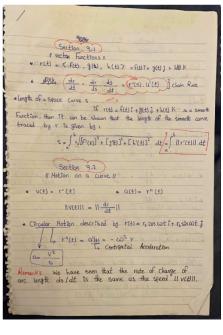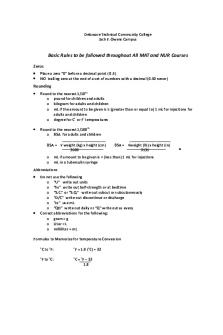General Rules for Asian Parliamentary Debate PDF

| Title | General Rules for Asian Parliamentary Debate |
|---|---|
| Author | Eli Guieb |
| Course | Bachelor of Arts in History |
| Institution | Polytechnic University of the Philippines |
| Pages | 5 |
| File Size | 99.2 KB |
| File Type | |
| Total Downloads | 46 |
| Total Views | 183 |
Summary
rules of debate...
Description
Asian Parliamentary Debate (General Rules) a) Teams There are two opposing teams in an Asian format of debate: 1. Government side- proposes and defends the motion 2. Opposition side- refutes and negates the motion. Each side is composed of at least six members depending on the class size. In this case, we have five (5) primary speakers (Prime Minister, Deputy, and three Whips), two (2) researchers and one (1) adviser. b) The Members of the government side are the following: 1. Prime minister (PM)- opens the debate, defines the motion and advances arguments. 2. Deputy prime Minister (DPM)- refute at first instance the case of the opposition, re-establish the government's claim, and advances arguments. 3. Government whips (GW)- makes an issue-based rebuttal of the opposition's case and summarizes the case of the government. c) The Members of the Opposition side are the following: 1. Leader of the Opposition (LO) - responds directly to the case of the government by giving a direct clash, and advances arguments. May challenge the motion if the definition is challengeable 2. Deputy Leader of the Opposition (DPL) - refutes the case of the DPM, re-establishes the case of the opposition, and advances an argument. 3. Opposition Whip (OW) - makes an issues-based rebuttal of the government's and summarizes the case of the opposition. d) Time of Speeches: Each speaker is allocated seven minutes to deliver their constructive speeches. One speaker from each side (For the Government: PM/DPM, for Opposition: LO/DLO) is given four minutes to deliver a reply speech. The speakers will be speaking in the following order: 1. Prime Minister (7 min) 2. Leader of the opposition (7 min) 3. Deputy Prime Minister (7 min) 4. Deputy Leader of the Opposition (7 min) 5. Government Whip (3 min each) 6. Opposition Whip (3 min each) 7. Opposition Reply (4 min) 8. Government Reply (4 min)
e) POI: During the constructive speeches, Point of Information (POI) may be raised by the opposing side after the first minute up to the sixth minute. POI may be refused or accepted by the speaker. During reply speeches, no POI may be raised. f) Reply Speech: Reply speech is a comparative analysis of the strength and weaknesses of the case of both sides. The aim of the speech is to give a bias judgment as to why should the people support the team's claim. The speech is first delivered by the opposition side and followed by the government side that will close the debate. g) Matter, Manner, Method: Asian Parliamentary Debate is assessed by an Adjudicator Panel composed of an odd number according to the following criteria: 1. Matter (40) - substance of the debate, the arguments and evidence presented, and the logical reasoning and presentation of said arguments. 2. Manner (40) - the style of delivery, the persuasion skills, and the conduct of the debaters. 3. Method (20) - the response to the dynamics of the debate, and the observance of the rules of debate. h) Speaker Roles in Asian Parliamentary Debate i) Government: Prime Minister (PM) Define context and parameters of debate. For example, in an open motion like "This House Would Support Musicians", the debate could be contextualized into whether music should be a commodity for trade, or it should be available gratis (i.e. free music download and transfer) Provide concise background or history leading to the issue Give framework of government bench's case. I.e. mechanisms (if any), argumentation flow (what the government's first argument is and what the Deputy Prime Minister will talk about) Introduce 1st argument; assert Government stand. Deputy Prime Minister (DPM) Rebut first argument from Leader of Opposition Rebut rebuttals to PM's argument Introduce 2nd and 3rd argument
Reassert Government stand and case
Government Whip Rebut Deputy Leader of Opposition, and Leader of Opposition Rebut rebuttals to DPM and PM arguments Provide a deeper level of analysis for previous arguments and rebuttals No new arguments, but new angles of arguments should be given Brief summary of entire case of Government Reassert Government stand and case ii) Opposition: Leader of Opposition: Agree or disagree with context/ parameters of debate (any definitional challenges, accusations of squirreling, or unfair set up should be made from the LO speech and no later) Rebut Prime Minister's argument Give framework for Opposition case (if Opp. agrees to problem, then their case should provide solution, or at least effectively highlight how Government proposal will worsen the situation) Introduce First Opposition argument Assert Opposition stand Deputy Leader of Opposition: Rebut DPM and PM arguments Rebut rebuttals to LO arguments Introduce 1st and 2nd (if any) argument Reassert Opposition stand and case Opposition Whip: Rebut DPM and PM arguments Rebut rebuttals to LO & DLO arguments Provide a deeper level of analysis for previous arguments and rebuttals No new arguments, but new angles of arguments should be given Reassert Opposition stand and case Reply Speech: Can only be done by either 1st or 2nd speaker from each bench Provide a biased 'oral adjudication' of why the debate should go to own bench Highlight issues you think your side won, carefully tip-toe around issues you think you lost New examples to expand on discussed examples is usually allowed and makes the reply speech sound fresh as opposed to verbal regurgitation Reassert stand
K) Roles of Speakers in Asian Parliamentary Format Government Opposition 1. Respond to Definition and PM Prime Minister 1. Define and Set-Up the Set-Up Debate 2. Present Position &Case 2. Present Position & Case 3. Rebut Government Case 3. Make 1 or 2 Arguments 4. Make 1 or 2Arguments 1. Defend Your Case DPM Deputy Prime 1. Defend Your Case 2. Attack DPM and PM’s Case Minister 2. Attack LO’s Case 3. Make 1 or 2Arguments 3. Make 1 or 2 Arguments 1. Briefly Summarize Your GW Government 1. Briefly Summarize Your Team’s Case Whip Team’s Case 2. Summarize and Prioritize 2. Summarize and Prioritize the main issues in the debate the main issues in the 3. Rebut and Analyzemain debate issues 3. Rebut and Analyze main issues *Remember, you cannot bring new arguments into the *Be sure to respond to new debate. You can respond to arguments delivered by the GW speaker if you choose DLO. You can do this to. separately (as part of 3) or include them in your summary of main issues (part of 2) GR Government 1. Briefly Summarize the 4. Briefly Summarize the Reply Debate Debate 2. Summarize the Position of 5. Summarize the Position of your team and your your team and your Opponent Opponent 6. Compare and show why 3. Compare and show why your team is better your team is better
L) Date and Rounds of Debate First Round: September 25 and 26 (Monday and Tuesday) Topic: Location of the First Mass in the Philippines
LO Leader of Opposition
OW Opposition Whip
OR Opposition Reply
Government: Limasawa, Leyte Opposition: Mazua, Butuan Second Round: October 1 and 2 Topic: Location of the First Cry of Revolution Government: Pugad Lawin Opposition: Balintawak Third Round: October 8 and 9 Topic: Retraction of Rizal Government: Yes Opposition: No M) Inter-Class Debate (this will serve as your final requirement) When: October 13, 2018 Where: Amphitheater, Intramuros, PUP Manila Time: 9 am-3 pm Materials to prepare: Buzzer Flags Podium Table Note:
Attendance is a must in every round of debate Speakers are required to wear formal attire during their scheduled debate Result of every round will be announced a week after Results are final and irrevocable...
Similar Free PDFs

Debate Tactics for Debate
- 3 Pages

Informations for Debate
- 12 Pages

Parliamentary Sovereignty
- 4 Pages

Parliamentary Committees
- 2 Pages

Parliamentary Sovereignty
- 2 Pages

Parliamentary sovereignty
- 7 Pages

Parliamentary Sovereignty
- 5 Pages

Rules for naming compounds
- 2 Pages

all rules for 233
- 15 Pages

Game Rules for cricket
- 6 Pages

Parliamentary Sovereignty
- 2 Pages

Parliamentary Sovereignty
- 6 Pages

Math Rules for Nursing
- 2 Pages

Rules FOR Significant Figures
- 2 Pages
Popular Institutions
- Tinajero National High School - Annex
- Politeknik Caltex Riau
- Yokohama City University
- SGT University
- University of Al-Qadisiyah
- Divine Word College of Vigan
- Techniek College Rotterdam
- Universidade de Santiago
- Universiti Teknologi MARA Cawangan Johor Kampus Pasir Gudang
- Poltekkes Kemenkes Yogyakarta
- Baguio City National High School
- Colegio san marcos
- preparatoria uno
- Centro de Bachillerato Tecnológico Industrial y de Servicios No. 107
- Dalian Maritime University
- Quang Trung Secondary School
- Colegio Tecnológico en Informática
- Corporación Regional de Educación Superior
- Grupo CEDVA
- Dar Al Uloom University
- Centro de Estudios Preuniversitarios de la Universidad Nacional de Ingeniería
- 上智大学
- Aakash International School, Nuna Majara
- San Felipe Neri Catholic School
- Kang Chiao International School - New Taipei City
- Misamis Occidental National High School
- Institución Educativa Escuela Normal Juan Ladrilleros
- Kolehiyo ng Pantukan
- Batanes State College
- Instituto Continental
- Sekolah Menengah Kejuruan Kesehatan Kaltara (Tarakan)
- Colegio de La Inmaculada Concepcion - Cebu

